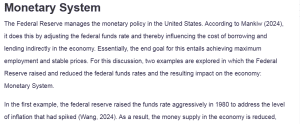Monetary System
The Federal Reserve manages the monetary policy in the United States. According to Mankiw (2024), it does this by adjusting the federal funds rate and thereby influencing the cost of borrowing and lending indirectly in the economy. Essentially, the end goal for this entails achieving maximum employment and stable prices. For this discussion, two examples are explored in which the Federal Reserve raised and reduced the federal funds rates and the resulting impact on the economy: Monetary System.
In the first example, the federal reserve raised the funds rate aggressively in 1980 to address the level of inflation that had spiked (Wang, 2024). As a result, the money supply in the economy is reduced, causing a higher opportunity cost for consumers and reduced investment and consumer spending in the economy. By the year 1983, inflation had reduced to 3.2% for the high of 13.5%. Despite the reduction, a recession in the economy was experienced since the high borrowing costs led to a reduced aggregate demand.
In the second example, the Federal Reserve lowered the funds rate significantly in 2007 going into 2008. The rate was reduced from 5% to below 1% to combat the economic recession by encouraging consumption and investment. Further, this was aimed at stimulating economic activity within the U.S. economy and achieving an increased employment rate and indeed, the rate rose to 10% in 2009 (Blinder, 2023). However, this does not mean that the measure attained success in mitigating the crisis, as the recovery rate was slow because the crisis was massive.
Also, their level of consumer confidence was still low, and expenditure remained relatively low. Overall, the two examples show that the Federal Reserve can influence major economic factors in the economy such as employment levels. Further, through monetary policy, deserved shifts in demand and supply can be attained to stabilize economic fluctuations.
References
Blinder, A. S. (2023). Landings, soft and hard: The federal reserve, 1965–2022. Journal of
Economic Perspectives, 37(1), 101-120. https://www.jstor.org/stable/27192411
Mankiw, N. G. (2024). Principles of economics (10th ed.). Cengage Learning.
Wang, N. (2024). A Study of the Financial Crisis and Relevant Monetary Policies. Highlights in
Business, Economics and Management, 32, 78-84. https://doi.org/10.54097/gvfmpp47
ORDER A PLAGIARISM-FREE PAPER HERE
We’ll write everything from scratch
Question 

Monetary System
Please be sure to cite all reference sources and reference all citations. You may add graphs or charts when applicable. Paraphrase extended quotes and cite following current APA citation guidelines even when you paraphrase.
Please always develop an initial post with an organized, clear point of view or idea using rich and significant detail, provide relevant and meaningful response posts with clarifying explanations and details, and posts that are easily understood, clear, and concise using proper APA-7/e citation methods where applicable with no errors in citations. Always cite all supporting references starting with the textbook using the current APA-7/e citation guidelines.